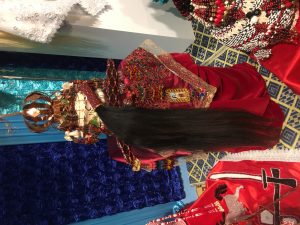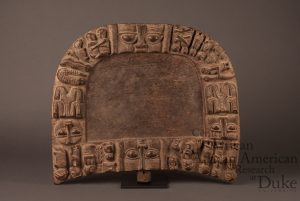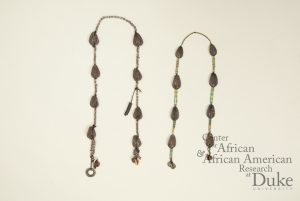When walking into the museum it’s easy to become quickly overwhelmed by the number of interesting and eye catching objects. While walking around the exhibit you’ll see everything from emptied rum bottles that have been transformed with beads and other materials into representations of the gods, to a small statues that are meant to control the spirits of the dead so they can be used by the living. During one visit to the museum when I was looking at the objects on the altar dedicated to Yemaya, goddess of the living sea and mother of all, it was an object that wasn’t included on the altar that peaked my interest the most. Held on a pedestal in the glass case next to the altar was an altar crown to Yemaya from Cuban Santeriá, or as it is more commonly known in Cuba, as Regla de Ocha. The crown, while being displayed the same as the other objects in the case grabs the attention of the viewer more. The 7 smaller crowns that make up the one, the blue gems, and the chains hanging down from the crown with small metal charms capture the attention of the viewer drawing them in to read the description of the object, and to learn the story behind it.

To understand how the crown is made and the reasoning behind each portion of the crown we must first understand the goddes that the crown is made for. Yemaya is the goddess of the sea and is often perceived as a mother to all. Her most sacred places in nature are those associated with water, the oceans, lakes, and lagoons, the color that represents Yemaya or her caminos (avatars or “roads”, which essentially are different versions of herself) are the colors blue and white. Her sacred number is 7, for her 7 caminos, and representative of the 7 seas. Yemaya influences more than just the sea though, as she is seen and known as a mother to all, she also influences family and women’s issues, pregnancy, children, and she is also associated with healing. Our ability to understand the goddess that the crown is made for will allow us to make the connections to understand the creation of the crown as a whole.
The crown contains many parts that we can link back to the goddess Yemaya, the 7 smaller crowns, 7 blue gems found in between each of the crowns all connect back to her sacred number. As well as this there are 21 chains that hang down from the crown, each of these chains have small silver charm that represents either yemaya or one of her many allies, as well as her sacred number since 21 is a multiple of 7. The key is associated with Elegguá, the god of all roads, cross roads and doors, without his blessings nothing can get done as he allows the prayers of those who practice Santeriá to reach the intended orisha. The horseshoe, the hammer, the hatchet, the sickle and the scythe, the anvil, the sledgehammer, the knife, the saw and the machete all represent Yemaya’s husband Ogún, who is a powerful warrior, who defends those who worship him. The snake represents her other husband Obatalá, who is the eldest and most powerful of all the orisha, he is said to be the father of many of the other orisha and is said to be the owner of all heads, both spiritual and outer. The lightening bolt and the sword represent her son Chango, who is the god of thunder lightening, and leadership. The 3 quills to represent her daughter-in-law Obba, who is considered to be the goddess of marriage and home, who waits for her husband Chango even though he cheats on her with the other goddesses. The sun, moon, ship’s wheel and the anchor embody Olokun, who is the goddess of the deep sea, some of the same charms are also sometimes associated with Yemaya. The charms that remain represent Yemaya and her own powers.
Altar crowns are very often found in the homes of worshippers on their own altars and are considered to be a central part in them. The altar crown would sit on top of soup tureen which would be decorated to match the orisha being worshiped, in the case of the altar crown that we are looking at it would be for Yemaya, so the colors would be blue and white. Within these tureens symbols to the gods or objects that please the gods would be placed within them. The altars and the objects on the altars are embodiments of the gods which means they are given the same respect. This means that the people who worship them wish to provide them with the best and most beautiful objects, and we can see that with the delicate beauty of the altar crown. Providing them with the most beautiful objects is not the only way though. By making sure that the objects are regularly cleaned and maintained as well as giving them offerings of food and drink they make sure that their gods on the altar are happy and well maintained.
This crown specifically, is used on altars of Cuban Santería or Regla de Ocha altars for the goddess Yemaya. Each piece of the crown can clearly be linked back to Yemaya or some other god or goddess of the Santeriá religion. It doesn’t just do this though, the object is able to link Santeriá back to its religious origins in the Yoruba religion with the chains that hang down off the crown. The chains that hang down create a veil, similar to those that are found on the crowns of the African Yoruba monarchs, connecting the current practices to those of its past. As well as looking into how this object demonstrates the fact that Santeriá is a diasporic religion we will also be looking at how syncretism is demonstrated as the crown also shares aspects with European styled crowns.
This object relates directly to the readings that we do in class as it demonstrates both a direct example of how the african diaspora works as is demonstrated throughout the religions as well as demonstrating the theories of hybridity and syncretism in a way that we can look at and see with our own eyes. To understand though how the object demonstrates how Santeriá is a diasporic religion of how it demonstrates syncretism, we first need to define both of the terms to truly understand and see the connection between the object and these topics.
Diaspora can be defined as a scattered population who originated from one location or as a population that has migrated from one location to another. Diasporic religions though are composed of memories of its place of origins and how it has changed since moving on. I believe the best description of a Diasporic religion though comes from Paul Johnson’s chapter Religions of the African Diaspora when he says, “African diasporic religions are transformed as they are accommodated in new sites and populations” (Johnson, 2013, 516). I think that this is the best definition because it relates to how the religions came over, and how they have changed. These Afro-Caribbean religions were brought over by the slaves taken out of their native countries during the Transatlantic Slave Trade, they brought their religions over, but because they were forced to hide their religion some of the aspects changed, transforming the religion into something new. This is clearly demonstrated in certain aspects of the crown, specifically with the chains that hang down with the small charms, the chains resemble the veil found on the on the African Yoruba monarchs, the classic traditions of the religion showing through despite the oppression of the religion, traditionally the objects that are attached to the chains would be found inside of the soup tureen. This is a demonstration of the african diaspora because there is a clear connection to Santeriá and its Yoruba roots.
The word syncretism is the most commonly used word when it comes down to the discussion between the mixing of religions or with the incorporation of a tradition into the religion or into certain aspects of the religion. Though syncretism is the word that is most commonly used with aspects of religion a word that we have seen being used often times with syncretism is hybridity, traditionally used only with organisms or objects, the two are usually paired together because they have similar ideas, in Johnson’s chapter Syncretism and Hybridization, he says “Syncretism and hybridity require ‘worlds’ of parallel entities that can it could be juxtaposed or joined. We don’t usually imagine ore or posit the creole, hybrid or syncretic possibilities of, say, dogs and plants, or Augustinian theodicy and snow tires, because such entities occupy different worlds.” (Johnson, 2016, 766) This shows us how hybridity and syncretism are related because they both require the objects that they are joining to be in the same “worlds” in this case the “world” that they have in common and are talking about in this situation is religion. The crown is a demonstration of syncretism through the aspects that the altar crown shares with some of the more traditional styles of European crowns. This is a demonstration of it because it is the combination of certain aspects from the crowns of Europe which play a religious role in certain aspects of christianity, for example, in the Catholic religion it is believed that those who go above average in certain aspects of the religion will receive a crown when they enter in the kingdom of heaven, the crown of righteousness for example, or the crowns that were worn by the monarchs as they traditionally had a role in the church. So the aspects of certain crowns found throughout Europe was combined with some of the aspects from traditional Yoruba crowns and were hybridized into this crown which is being used on a Santeriá altar, which is a clear demonstration of syncretism.
The altar crown for Yemaya in Cuban Santeriá is a clearly demonstrates the definitions of syncretism hybridity and the African Diaspora. Examples that prove this can all be found in the crown and in the reasons behind the various pieces that come together to form the finished product. From the 7 blue gemstones meant to represent Yemaya, to the charms hanging off the chains which represent Yemaya and her allies. The 7 small european looking crowns that bring back the memories of when they had to incorporate catholic traditions into their religion so that they could practice it in secret, and the chains that hang down off the crown connecting it back to the traditional crowns of the religion it was based off of. Each of the aspects of the crown demonstrate how the crown and Santeriá as a whole is a diasporic religion and the aspects that it took in through syncretism.
-Sam Brady
Bibliography
Matory, J. Lorand. ms. The Fetish Revisited: Marx, Freud, and the Gods Black People Make.
Flores-Peña, Ysamur, and Roberta J. Evanchuk. 2011. Santería garments and altars: speaking without a voice. Jackson: University Press of Mississippi.
Matory, J. Lorand “Artifacts.” Artifacts | The Sacred Arts of the Black Atlantic. Accessed October 30, 2017. http://sacredart.caaar.duke.edu/artifacts/1283#.
“Yemaya.” Santeria Church of the Orishas. Accessed October 30, 2017. http://santeriachurch.org/the-orishas/yemaya/.
Johnson, Paul Christopher. 2016. “Syncretism and Hybridization.” In The Oxford Handbook in The Study of Religion. Edited by Michael Stausberg and Steven Engler, 754-69. Oxford University Press.
Johnson, Paul Christopher. 2013. “Religions of the African Diaspora.” In A Companion to Diaspora and Transnationalism. Edited by Ato Quayson and Girish Daswani, 509-20. Blackwell Publishing









